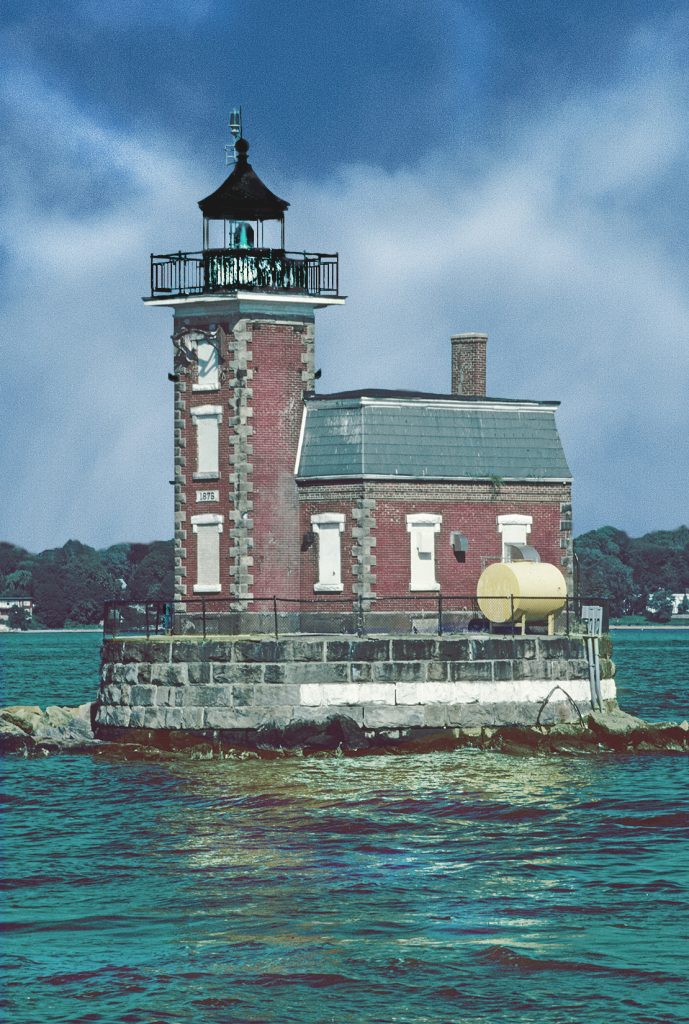
The attractive Second Empire Victorian-style lighthouse is a gateway to the East River and New York Harbor. Extending out from the shoreline on its southeast side, dangerous rock reefs are scattered throughout. Safe passage is to the northwest side of the structure.
Even before the birth of our Nation, the colony’s New York Harbor played a key role in our maritime history. During the mid-1600s the harbor was equipped with its first pier. In less than 50 years, the port served as the “bread-basket” of the Atlantic. It was our most important hub for exporting wheat to Europe and the West Indies. The East River with its direct connection to Long Island Sound became a major waterway to the coastal communities of the Sound and Rhode Island, and even farther north.
By 1837, it was estimated that over one hundred ships sailed past the future Execution Rocks Lighthouse, as they sailed in and out of the Sound. Sands Point Light, less than a mile south of Execution Rocks served to guide mariners away from its near-shore reefs. But in heavy fog or storm conditions, the light was found to be of little use. A lighthouse at Execution Rocks was thus established in 1850.

Rock reefs continued to be a concern near the gateway to the East River. Recognizing the area’s maritime hazards, Congress in 1866 appropriated $6,600 for the establishment of a lighthouse on Hart Island, some 3.5 miles west of Execution Rocks. Plans were made to erect a dwelling and pier on the site, but difficulties in obtaining the necessary parcel along with its associated cost forced a change in plans. The Light House Board opted instead to build a lighthouse at Stepping Stones. During the Colonial era, the site was known as “Devil’s Belt” due to the strong Northeasters that frequented the area and Long Island Sound. Earlier, according to Native American legend, the nearby rock reefs were known as “Devil’s Stepping Stones.”
On June 10, 1872, Congress appropriated an additional $50,000 for the construction of the sorely needed navigational beacon. Its design closely resembled a sister lighthouse, the Hudson-Athens Light, located on the Hudson River.
Construction of the lighthouse began during the summer of 1875. Riprap stones were laid out over the underlying rocks followed by concrete and more riprap. When completed, the square, red brick keeper’s dwelling was topped with a mansard roof and a square tower that stood 49 feet above sea level. Equipped with a fifth-order Fresnel lens showing a fixed red light, it was first lit on March 1, 1877. Findlay Fraser, the station’s first keeper, would remain two years at the lighthouse. He was then replaced by James Scott, who was credited with the rescue of three mariners during his tenure at the lighthouse. Scott was followed by at least eleven other civilian keepers. Sometime around 1955, Coast Guard personnel took complete charge of the station. It was automated in 1966.
In December 1888, Cornelius Douglass, the station’s fourth keeper, nearly met with a fatal accident while returning from City Island where he had picked up supplies. He was no more than a quarter-mile from the light when heavy waves and strong wind gusts capsized his vessel. Tossed into the frigid waters, he was able to cling to his overturned boat until rescued by a nearby vessel.
The winter storm of early February of 1934 prompted the New York Times to headline its article as “Now the Winter Storm Vents its Fury.” The storm created havoc for transatlantic vessels. Some entering New York Harbor were encased in ice while others also suffered damage from the horrific pounding of wind and waves. Earlier in January, the waves breaking over the cargo ship Exeter City, swept away its bridge, taking the lives of the captain and three crewmen. The remaining crew was rescued by the steamship, American Merchant. During the same storm events, Long Island Sound’s Cornfield Point Lightship was dragged off its station several times, while many coastal navigational buoys were swept away by the waves and ice.
The same persistent winter weather also endangered keeper Charles Rogers and his family at Stepping Stones. On February 9, the temperature had plunged to fourteen degrees below zero. A thick ring of sea ice formed around the entire light station. The ice persisted and eleven days later, the area was struck by a blizzard that dumped seventeen inches of snow! Unable to get to shore, the family was nearly out of food. As a call for help, the keeper flew the American flag upside down, an international distress signal. It was spotted from City Island, but the police launch stationed there was also ice-blocked. Luckily, the signal was seen from the tug Muppet. Its captain maneuvered his tug up against the ice surrounding the lighthouse and dispatched one of the crewmen toward the station. Crossing the ice field, he was met by the keeper. Charles Rogers refused any food from the tug but asked that the captain instead contact the Lighthouse Service authorities at St George, Staten Island. Later, that same day, the lighthouse tender Hickory made its way to Stepping Stones to deliver the much needed provisions.
Stepping Stones’ beacon displayed its fixed red light until 1932. It was then changed to a fixed green light. During the mid-1960s, a modern light was installed that showed a fixed, flashing green light. The beacon continues to operate today. It is a vital aid to local navigation. However, in 1966, the Coast Guard declared the structure itself excess property. It was in extremely poor condition and if not privately restored, the Coast Guard intended to demolish the structure and replace it with a steel tower.
In an effort to preserve the lighthouse, it was offered at no cost to various agencies and non-profit organizations. In 2008, custody of the lighthouse was turned over to the Town of North Hempstead. Later, the Stepping Stones Lighthouse Preservation Society of the Great Neck Historical Society joined the town to help raise funds for its restoration. The society has raised over $100,000. The town has allocated funds in their 2022 capital budget for its preservation, but at an estimated cost exceeding 4-million dollars, a great deal more is needed. In 2005, the lighthouse was added to the National Register of Historic Places, but the attractive one and a half-century old “navigational aid” needs help from anyone that loves lighthouses and recognizes their important contribution to our maritime history. Tax-deductible donations can be made via the Great Neck Historical Society Lighthouse Fund, P.O. Box 234483, Great Neck, NY 11023.
Once fully restored, Stepping Stones Lighthouse “will provide a magnet for educational programs and tours, a focal point for historical research, an icon for promoting safe boating, and a location for monitoring the environmental health of Long Island Sound.”
